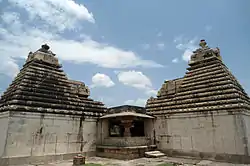Panagal, Nalgonda district
Panagal or Panagallu is a historic town located 4 km from Nalgonda town in Telangana, India. Panagal was one of the capitals of Kunduru Chodas who ruled parts of eastern Telangana in the 11th and 12th centuries.
Panagal
పానగల్లు Panagallu, Panugal | |
|---|---|
Town | |
 Sri Chaya Someswara Temple at Panagal | |
| Country | |
| State | Telangana |
| Languages | |
| • Official | Telugu |
| Time zone | UTC+5:30 (IST) |
| Vehicle registration | TS 05 |
| Nearest cities | Nalgonda, Suryapet |
| Website | telangana |
The town is home to two historic temples - Chaya Someswara temple and Pachala Someswara temple built in the 11th and 12th centuries during the reign of Kunduru Chodas and Kakatiyas over the region. It is also home to Panagal museum established in 1982 and contains many sculptures, prehistoric tools, coins, bronzes, beads, arms and weapons, and copper plate inscriptions.
History
Panagal of Nalgonda was also an important religious place during Kakatiya period. An inscription mentioning the name of Kakatiya's greatest king Pratap Rudra on Pachala Someswara temple supports the claim that these temples were erected for the greater glory of the Kakatiya ruler's favourite god, Shiva. There are two famous Shiva temples, Chaya Someswara temple and Pachala Someswara temple. The Shiva lingam of Chaya Someswara (chaya means "shadow" in Telugu) is, when daylight is present, straddled by a permanent shadow of a pillar. The pillars of the temple are decorated in great detail with relief sculpture of episodes from the two great Epics of India, the Ramayana and the Mahabharata.
Statues and sculptures of Hindu gods and goddesses dating back to Andhra Ikshvakus of 3rd century CE are preserved and protected at the museum constructed in the compound of Pachala Someswara Swamy temple. Some of the ancient Siva lingas preserved in the museum were collected from a village called Yelleswaram (a Saivite centre), which was submerged during the construction of Nagarjuna Sagar dam.
During late 14th Century and early 15th century, there was an equilibrium of sorts between Recherla Padmanayaks in Central Telangana, Panta Reddis in Coastal Andhra, Bahmani Sultans of Gulbarga in Western Telangana and Eastern Gangas of Kalinga in the North East (modern Srikakulam and Vijayanagaram). In the south were Vijayanagara kings, in Udayagiri fort (operating from Udayagiri, with base in Vijayanagara).
Recherla Padmanayaks, operating from Rachakonda (Samsathan Narayanpur, near Choutuppal) and Devarakonda, were regional adversaries of Panta Reddis.
The Panta Reddis had established their bases in two places - Kondaveedu and Rajahmundry, the ones from the latter being the juniors. A fratricidal war broke out between Kondaveedu Reddis and Reddis of Rajahmundry. The Kondaveedu Reddis who were in allegiance with Vijayanagara Kings for fending off Recherla Padmanayaks, switched their allegiance to Bahmanis as Vijayanagara kings started reaching out to Rajahmundry Reddis. This in turn angered Recherla kings who till then were in allegiance with Bahmanis to fend off Viyanagara push into the Recherla territories, shifted their allegiance to Vijayanagara kingdom out of pure realpolitik.
A major battle was fought in 1419 at Panagal that led to the victory of Vijayanagara-Rajahmundry Reddi-Recherla Padmanayaks. After this battle, the Kondaveedu Reddi dynasty gradually got extinct.
References
- Panagal Utsavalu 2016
- Official Website of the Nalgonda District
- Chaya Someswaralayam (wikimapia location)
- Pachchala Someswaralayam & archaeological museum
- Precolonial India in Practice - Society, Region, and Identity in Medieval Andhra - Cynthia Talbot, Oxford University Press 2001, Pages 180, 181